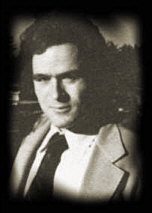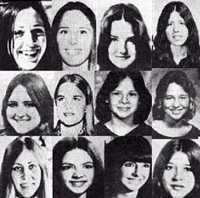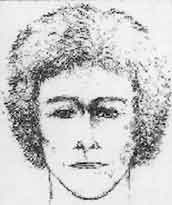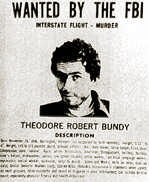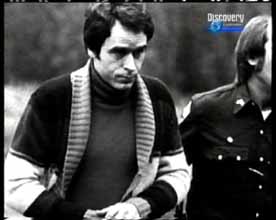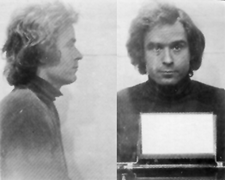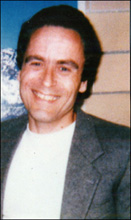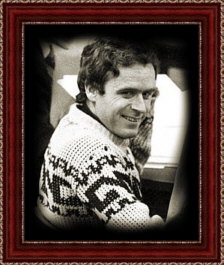 Theodore Robert
Bundy Theodore Robert
Bundy 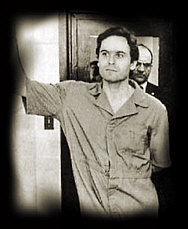 Ted Bundy is a striking contrast to the general image of a "homicidal maniac": attractive, self-assured, politically ambitious, and successful with a wide variety of women. But his private demons drove him to extremes of violence that make the gory worst of modern "slasher" films seem almost petty by comparison. With his chameleon-like ability to blend, his talent for belonging, Bundy posed an ever-present danger to the pretty, dark-haired women he selected as his victims
.
Linda Healy was the
first fatality. On January 31, 1974, she vanished from her
basement lodgings in Seattle, leaving bloody sheets behind, a
blood-stained nightgown hanging in her closet. Several blocks away,
young Susan Clarke had been assaulted, bludgeoned in her bed a few
weeks earlier, but she survived her crushing injuries and would
eventually recover. As for Lynda Healy, she was gone without a trace. 
Police had no persuasive evidence of any pattern yet, but it would not
be long in coming. On March 12, Donna Fail Manson disappeared en route
to a concert in Olympia, Washington. On April 17, Susan Rancourt
vanished on her way to see a German language film in Ellensburg. On May
6, Roberta Parks failed to return from a late-night stroll in her
Corvallis neighborhood. On June1, Brenda Ball left Seattle's Flame
Tavern with an unknown man and vanished, as if into thin air. Then days
later, Georgann Hawkins joined the list of missing women, lost
somewhere between her boyfriend's apartment and her own sorority house
in Seattle.
Now
detectives had their pattern. All the missing women had been young,
attractive, with their dark hair worn at shoulder length or longer,
parted in the middle. In their photos, laid out side-by-side, they
might have passed for sisters, some for twins. Homicide investigators
had no corpses yet, but they refused to cherish false illusions of a
happy ending to the case. There were so many victims, and the worst was
yet to come.
July 14. A crowd assembled on the shores of Lake Sammamish
to enjoy the sun and water sports of summer. When the day was over, two
more names would be appended to the growing list of missing women:
Janice Ott and Denise Naslund had each disappeared within sight of
their separate friends, but this time police had a tenuous lead.
Passers-by remembered seeing Janice Ott in conversation with a man who
carried one arm in a sling; he had been overheard to introduce himself
as "Ted." With that report in hand, detectives turned up other female
witnesses who were themselves approached by "Ted" at Lake Sammamish. In
each case, he had asked for help securing a sailboat to his car. The
lucky women had declined, but one had followed "Ted" to where his small
Volkswagen "bug" was parked; there was no sign of any sailboat, and his
explanation - that the boat would have to be retrieved from a house "up
the hill" - had aroused her suspicions, prompting her to put the
stranger off.
Police now had a fair description of their suspect and his car. The published references to "Ted" inspired a rash of calls reporting "suspects," one of them in reference to college student Theodore Bundy. The authorities checked out each lead as time allowed, but Bundy was considered "squeaky clean;" a law student and Young Repulican active in law-and-order politics, he once had chased a mugger several blocks to make a citizen's arrest. So many calls reporting suspects had been made from spite or simple overzealousness, and Bundy's name was filed away with countless others, momentarily forgotten. On September 7, hunters found a makeshift graveyard on a wooded hillside several miles from Lake Sammamish. Dental records were required to finally identify remains of Janice Ott and Denise Naslund; the skeleton of a third woman, found with the others, could not be identified. Five weeks later, on October 12, another hunter found the bones of two more women in Clark County. One victim was identified as Carol Valenzuela, missing for two months from Vancouver, Washington, on the Oregon border; again, the second victim would remain unknown, recorded in the files as a "Jane Doe." Police were optimistic, hopeful that discovery of victims would eventually lead them to the killer, but they had no way of knowing that their man had given them the slip already, moving on in search of safer hunting grounds and other prey. The terror came to Utah on October 2,1974, when Nancy Wilcox disappeared in Salt Lake City. On October 18, Melissa Smith vanished in Midvale; her body, raped and beaten, would be unearthed in the Wasatch Mountains nine days later. Laura Aime joined the missing list in Orem, on October 31, while walking home in costume from a Halloween party; a month would pass before her battered, violated body was discovered in a wooded area outside of town. A man attempted to abduct attractive Carol Da Ronch from a Salt Lake City shopping mall November 9, but she was able to escape before he could attach a pair of handcuffs to her wrists. That evening, Debbie Kent was kidnapped from the auditorium at Salt Lake City's Viewmont High School. Authorities in Utah kept communications open with police in other states, including Washington. They might have noticed that a suspect from Seattle, one Ted Bundy, was attending school in Utah when the local disappearances occurred, but they were looking for a madman, rather than a sober, well-groomed student of the law who seemed to have political connections in Seattle. Bundy stayed on file, and was again forgotten. With the new year, Colorado joined the list of hunting
grounds for an elusive killer who apparently selected victims by their
hairstyles. Caryn Campbell was the first to vanish, from a ski lodge at
Snowmass on January 12; her raped and battered body would be found on
February 17. On March 15, Julie Cunningham disappeared en route to a
tavern in Vail. One month later to the day, Melanie Colley went missing
while riding her bicycle in Nederland; she was discovered eight days
later, dead, her skull crushed, with her jeans pulled down around her
ankles. On July 1, Shelly Robertson was added to the missing list in
Golden; her remains were found on August 23, discarded in a mine shaft
near the Berthoud Pass.
A week before the final, grim discovery, Ted Bundy was arrested in Salt Lake City for suspicion of burglary. Erratic driving had attracted the attention of police, and an examination of his car - a small VW - revealed peculiar items such as handcuffs and a pair of panty hose with eyeholes cut to form a stocking mask. The glove compartment yielded gasoline receipts and maps that linked the suspect with a list of Colorado ski resorts, including Vail and Snowmass. Carol Da Ronch identified Ted Bundy as the man who had attacked her in November, and her testimony was sufficient to convict him on a charge of attempted kidnapping. Other states were waiting for a shot at Bundy now, and in January 1977 he was extradited to Colorado for trial in the murder of Caryn Campbell, at Snowmass. Faced with prison time already, Bundy had no time to spare for further trials. He fled from custody in June, and was recaptured after eight days on the road. On December 30 he tried again, with more success, found lodgings on the outskirts of Florida State University. Suspected in a score of deaths already, Bundy had secured himself another happy hunting ground. In the small hours of January 15, 1978, he invaded the Chi Omega sorority house, dressed all in black and armed with a heavy wooden club. Before he left, two women had been raped and killed, a third severely injured by the beating he inflicted with his bludgeon. Within the hour, he had slipped inside another house, just blocks away, to club another victim in her bed. She, too, survived. Detectives at the Chi Omega house discovered bite marks on the corpses there, appalling evidence of Bundy's fervor at the moment of the kill. On February 6, Ted stole a van and drove to Jacksonville, where he was spotted in the act of trying to abduct a school girl. Three days later, twelve-year-old Kimberly Leach disappeared from a schoolyard nearby; she was found in the first week of April, her body discarded near Suwanee State Park. Police in Pensacola spotted Bundy's stolen license
plates on February 15, and were forced to run him down as he attempted
to escape on foot. Once Bundy was identified, impressions of his teeth
were taken to compare with bite marks on the Chi Omega victims, and his
fate was sealed. Convicted on two counts of murder in July 1979, he was
sentenced to die in Florida's electric chair. A third conviction and
death sentence were subsequently obtained in the case of Kimberly Leach. After ten years of appeals, Bundy was finally executed in February 1989
In his last interview he confessed to
a total of 28 murders.
WE ARE EVERYWHERE. AND THERE WILL BE MORE OF YOUR CHILDREN DEAD TOMORROW." THEODORE ROBERT BUNDY
Copyright
© 1999 Rick Allan. All rights reserved.
Revised: August 2005. |

